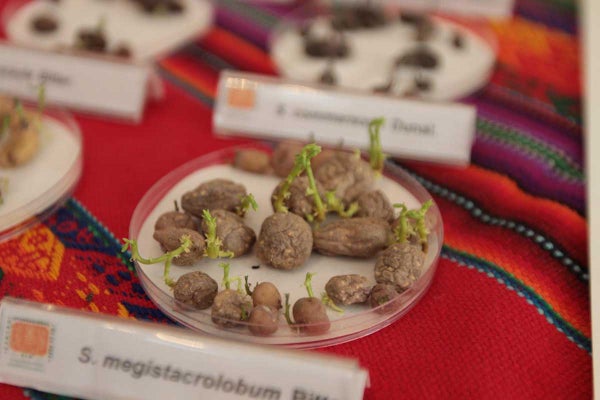The potato, whether fried, roasted or mashed, is one of the most popular foods in the world—not only is it delicious and versatile, it also needs little water and adapts well, thriving in extreme environments where other vegetables are hard-pressed to grow. And then there is its nutritional value. According to the U.S. Department of Agriculture, consuming a single russet-type potato can add nearly 10 percent of the daily recommended caloric load, providing four grams of fiber, five of protein and only two of sugar.
This data has motivated a group of scientists from NASA to team up with the International Potato Center, or CIP (Spanish abbreviation), in Peru to conduct an experiment growing potatoes in conditions similar to Mars, with the hope of generating food for possible future manned missions to the Red Planet.
The study began in January and scientists hope to have the first results in three months, says Joel Ranck, CIP spokesperson. For the first phase of the experiment, researchers will try to plant type LTVR (lowland tropic virus-resistant) potato clones. An important feature of this variety is resistance to some of the viruses that most commonly attack potatoes such as PVY, PVX and PLRV. Among its other traits: it ripens fast—in 90 to 100 days; can produce tubers at high temperatures; and has high drought tolerance.
On supporting science journalism
If you're enjoying this article, consider supporting our award-winning journalism by subscribing. By purchasing a subscription you are helping to ensure the future of impactful stories about the discoveries and ideas shaping our world today.
The potato clones will be planted in soil samples taken from La Joya Pampas, a sector of the Atacama Desert. With an area of some 105,000 square kilometers an covering parts of Peru, Chile, Argentina and Bolivia, the Atacama is regarded as one of the driest, most desolate places on Earth. “The soils of the Atacama and Mars have much in common,” says Julio Valdivia-Silva, a microgravity and space biology researcher at the National Institute for Research and Training in Telecommunications of Peru, and principal scientist of the experiment. During the past 12 years Valdivia has studied the characteristics of the Atacama Desert and its similarities with the soils of Mars. “Both have extremely low levels of microorganisms and organic material as well as high levels of oxidizing chemical elements. For these reasons, the soils in Atacama have been used as analogous to Mars in research scenarios.”
During the second phase of the project researchers will try to freeze the fruits obtained. “The trip from Earth to Mars can take about nine months, and during that time we must…[keep]…potatoes from germinating. So we want to freeze them and thaw them in order to learn if we can revive them and plant them in Martian soil at the right time,” Ranck said.
For the third and last phase of the experiment, CIP scientists will try growing potatoes inside CubeSats in space. “We want to explore how they grow within a controlled atmosphere. One of the most important features of Mars is its low atmospheric pressure, and in order to study how the plant reacts, we need a confined environment such as we can have with the CubeSat,” Valdivia-Silva says.
Collective project
Scientists hope to be able to increase the data collection with the help of researchers and students at various universities. The idea is for students from different corners of the planet to prepare the CubeSats with substrates and potatoes. Melissa Guzman, a researcher in planetary science and astrobiology at NASA Ames Research Center in California, will coordinate the effort from the U.S. "What we want is that the students use CubeSat modules to compile data that we can then compare with the one obtained in Peru. It is a very exciting idea, to think that potatoes could be one of the first meals of future Mars astronauts,” Guzman says.
But it is not all about Mars. Scientists believe that the information gathered will also provide valuable data to find practical solutions to problems potato crops face on Earth, including the effects of global warming. “Our CIP scientists have found that certain extreme climatic conditions hinder the viability of crops. [The] potato is a highly nutritious food that can save many people from starvation. In Peru alone we have 4,000 different species. Perhaps it is a bit ironic that we have to look at Mars to understand ourselves, but no doubt that is also interesting,” Ranck says.
